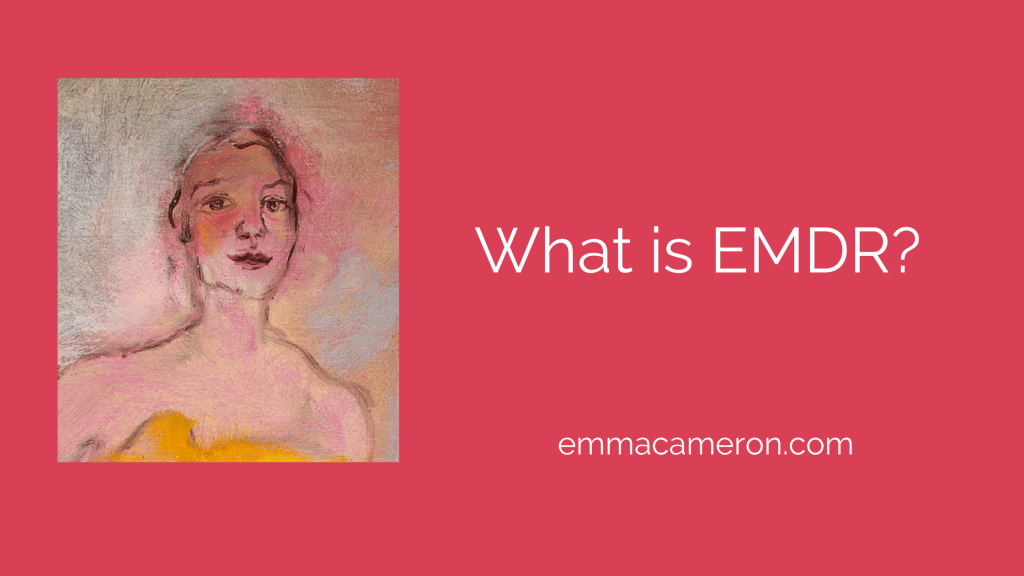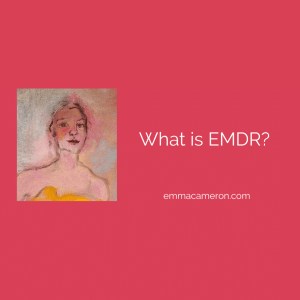
EMDR therapy is approved by NICE in the UK as an effective treatment for PTSD (post-traumatic stress disorder). Single-incident traumas (such as violent incidents, sexual assault, road traffic accidents and terrorist attacks) are particularly likely to respond well to EMDR treatment. EMDR can also be used for helping treat anxiety, shame, phobias, complex trauma, and more. EMDR was originated and developed by Francine Shapiro, PhD.
So what is EMDR, and how does EMDR therapy work?
EMDR is a powerful kind of psychotherapy which appears to unlock your brain’s natural healing processes after trauma has caused a blockage or glitch in your emotional healing system. No one exactly knows how or why EMDR works, but it is believed that the success of this treatment, when it works, is due to ‘adaptive information processing’ (AIP) – the in-built natural ability of your brain and nervous system to process traumatic information under the right circumstances.
EMDR Therapy – What is it? Share on XEMDR stands for ‘Eye Movement Desensitization and Reprocessing’. There are specific stages within EMDR treatment, and a clear protocol that EMDR therapists use. The stage that is most obviously “EMDR-ish” is where the client is guided to bilateral stimulation.
Bilateral stimulation could be tapping alternate sides of the body (a recent interview with Prince Harry showed him doing this, using what’s sometimes called ‘the butterfly hug’ to alternately tap each side of his upper chest as his therapist taught him). A client might also tap their thighs; or follow a moving series of lights with their eyes. The therapist’s fingers may be held up and used as a moving object for the client to track with their eyes. (This is the bit that gets shown on TV, usually in a heavily fictionalised manner that bears little resemblance to the way EMDR is actually done!) While the bilateral stimulation is going on, the client is encouraged to use their mind and emotions to process the painful memories and move through experiencing all the body sensations and emotions that come up. The tapping or eye movements help the person not to get too overwhelmed by these sensations, which can be quite intense.
EMDR treatment must be done in phases over many sessions, and not rushed. Depending on the person and their particular needs, the phases of EMDR could take place over several months of once-a-week therapy. Unlike in the media portrayals, EMDR is rarely a ‘quick fix’.
Here’s a clip in which Jameela Jamil tells Russell Brand about her personal experience with EMDR therapy.
Is EMDR the best option?
EMDR is likely to be a good option for many people, especially if their issue is a single-incident trauma such as an accident. But it’s important to remember that its effectiveness depends on several factors, particularly the skills of the therapist and the ‘fit’ between the client and the therapist. And it’s also important to know that there are many other types of therapy that can be just as effective, or even more so.
One valuable thing about EMDR is that it’s an experiential ‘bottom-up’ treatment. This means that the person’s bodily and emotional experiences are involved, as opposed to a thought-based ‘top-down’ treatment like CBT (Cognitive Behavioural Therapy) which relies on helping the person try to change the way they think and behave. For trauma, experiential treatments are recommended because they target the whole person (body, mind and emotions) rather than just trying to encourage someone to think differently about things.
Other types of therapy that are experiential include AEDP (Accelerated Experiential Dynamic Psychotherapy), ISTDP, Gestalt, Sensorimotor psychotherapy, Somatic Experiencing, Brainspotting, Integrative Arts Psychotherapy, and IFS (Internal Family Systems). These may all be particularly well suited for someone who has had longstanding difficulties which don’t solely come from a single traumatic event.
You may like to read my article about what has changed in modern trauma therapy, in which I discuss ways that trauma is treated nowadays compared with in the past.
Risks of EMDR
There are some risks associated with EMDR, although if done by a skilled practitioner it is usually very safe in most cases.
Hyperarousal and hypoarousal
EMDR appears to activate complex memory networks, within a short time frame, and although this is part of the strength and power of EMDR treatment, it can also amplify risks. A client’s nervous system can leave its ‘window of tolerance’ and become hyperaroused or hypoaroused. If this is not well managed by the therapist, or if resourcing is insufficient, EMDR therapy can be harmful. This is why it is important that the therapist has a solid background training in psychotherapy and/or counselling, and has plenty of experience in working with trauma clients. This should help them assess risk in order to prevent harm (as far as possible) and means the therapist can intervene effectively if things do get difficult.
Dissociation and retraumatisation
Risks of EMDR include dysregulation and/or dissociation. This can happen where the person’s nervous system goes outside its ‘window of tolerance’ and their feelings become too much for them to handle. A skilled therapist knows how to manage this and can usually help the person feel okay again before the end of the session. Another risk is that the therapy goes too fast, and exposes the person to ‘too much, too soon’. Previously repressed memories can be opened up without enough safeguards in place. This can retraumatise the person. Then the person has a whole other layer added to the trauma they were already having to deal with! Another unfortunate result of this can be that the person may be put off seeking any kind of therapy again, and thus may never succeed in getting the help they need and deserve.
Limited effects
EMDR is highly focused, targeting specific memory systems. It may desensitise a particular memory, but leave the larger issue, or other problems such as problematic character traits or tendencies, left untreated. Another risk is that it can’t usually be generalised for the person to use for self-help, unlike other types of therapy which teach skills for ongoing self-management. And as with any type of therapy, it can happen that EMDR is simply ineffective for a particular individual.
Some EMDR practitioners don’t have enough underlying therapy training
Currently in the U.K. there are cases where other professionals (occupational therapists, nurses, and wellbeing practitioners) practise EMDR despite not having much counselling or psychotherapy training. EMDR in these circumstances could still be helpful and useful, but there are more risks, as the professional may not have the skills needed to handle some reactions and situations that may develop.
Some therapists have insufficient EMDR training
There are lots of ‘EMDR trainings’ to be found on Google, but some are inadequate and do not teach to the standard required for optimal safety and effectiveness. Make sure your therapist was trained via an organisation accredited by EMDR Europe. This ensures that the therapist was already a fully qualified psychotherapist, HCPC registered Art Therapist, counsellor or counselling psychologist before completing their EMDR training, and that they’re fully insured. It is also important that you feel emotionally safe with the therapist, and that they spend plenty of time (usually several sessions minimum) doing the stabilising and resourcing work with you that is a vital part of EMDR treatment.
Who shouldn’t have EMDR?
Most practitioners would avoid using EMDR with clients with dissociation, acute mental health conditions, epilepsy, or the early or late stages of pregnancy.
How to get EMDR treatment
You might be able to access EMDR via the NHS, via your GP who may be able to refer you to an NHS psychologist or Art Therapist who offers this treatment. EMDR is also available privately, via a psychotherapist or counsellor who has had additional specialist training in EMDR. (If someone claims to offer EMDR privately, please be cautious and make sure they’re properly trained*). You may wish to read my ‘Beginner’s Guide to Finding a Therapist in Essex’ which is intended to guide you through the initial stages of finding a therapist. Many EMDR practitioners are currently working online-only, due to the pandemic. Update: Please note that at the moment, I myself am not currently offering EMDR to new clients.
Further reading & viewing:
https://hellogiggles.com/lifestyle/emdr-therapy-trigger-warnings-helped-me/
EMDR and Trauma: What You Need to Know
How Grey’s Anatomy Got that EMDR Therapy Episode So Right
Tapping into the Benefits of EMDR
